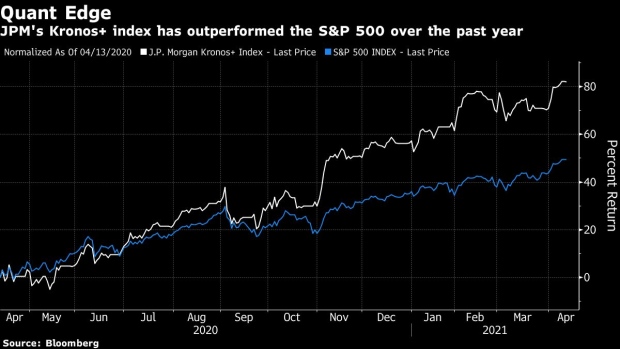Apr 15, 2021
JPMorgan Sells an Exotic Quant Trade Chasing Stock-Market Whales
, Bloomberg News

(Bloomberg) -- JPMorgan Chase & Co. is tapping into retail demand for trend-following by giving rich investors access to a kind of complex stock strategy that’s usually reserved for institutional managers.
The New York-based bank has issued $15 million of structured notes that give investors a way to surf S&P 500 trading patterns caused by market whales including options dealers and pension funds.
The thinking goes that their trading, rebalancing and hedging activity are all giving rise to seasonal cycles and momentum trends in the world’s largest stock market.
The JPMorgan notes carry maturities of up to five years and track the performance of the bank’s Kronos+ index launched in December, according to SEC filings. While issuance to-date is modest, the deal gives wealthy individuals -- typical buyers of such securities -- a novel way to ride esoteric stock trends ignited by the systematic crowd.
It’s a window into a hot and opaque investing style on Wall Street.
The Kronos+ index captures the S&P 500’s tendency to outperform at the start and the end of each month, and to maintain its momentum going into monthly options expiry dates. A backtest suggests the gauge hasn’t had a down year since 2008, when it lost 54%. A spokesperson for JPMorgan declined to comment on the issuance.
“It makes sense to look at strategies such as this,” said Matthew Yeates, head of alternative and quantitative strategy at Seven Investment Management LLP. “It is difficult to see those distortions evaporating any time soon.”
Quants have long devised investing strategies to exploit institutional capital flows. Intraday trend-following for instance flourished in recent years as a way to take advantage of end-of-day trading by passive funds, though the style has struggled of late.
At the same time, an increase in options volumes means derivatives traders are moving stocks like never before -- fueling market quirks like those captured in the Kronos index.
Read More: Wall Street Dealers in Hedging Frenzy Get Blamed for Volatility
One is the propensity of the S&P to move in a reliable direction in the run-up to options expiry. If the benchmark has increased in the previous month, call overwriters will tend to buy back their contracts and sell new ones with higher strike prices to dealers. That in turn spurs market makers to buy the underlying equities as a hedge, according to JPMorgan. If the S&P 500 has fallen, the opposite occurs.
Hedging Tails
The Kronos index also seeks to exploit the tendency of the S&P 500 to outperform during the first and last few days of each month, as well as its reversion to the mean into the last week of the month. All this can be attributed to the buying and selling patterns of large investors adjusting their portfolios, according to the JPMorgan prospectus.
Think pension portfolios rebalancing their exposures or retirement funds buying stocks at the beginning of every month.
During bouts of market volatility, these trading patterns can get magnified. In that context, trades designed to follow systematic trading flows “can provide an attractive source of tail risk protection,” according to Yeates.
Still, like all investing styles borne out of backtests, it may ultimately struggle for traction in the real world. Smart strategies that look good on paper can misfire thanks to trading costs and market reversals.
“Seasonality offers alpha opportunities, but often these are theoretical rather than practical,” said Nicolas Rabener, founder and CEO of FactorResearch.
©2021 Bloomberg L.P.